The best compost for fruit trees will include organic matter that is well aged like leaf mould or homemade compost. Mushroom compost can be a good option and works best when mixed 50:50 with aged compost. This will add a range of nutrients, microorganisms and organic matter to improve drainage and to help to act as a mulch to reduce water loss from the soil. You can also mix in aged cow manure and top with bark chips to keep the water in.
The best time to apply a top dressing of compost to established fruit trees is early spring where the tree is actively growing and before the weather gets too hot.
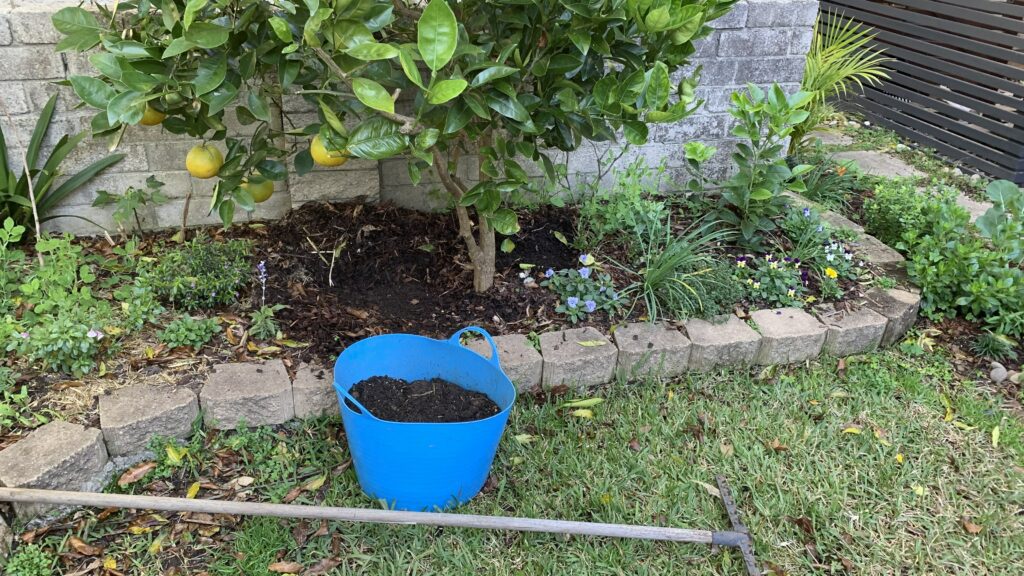
This article will explore the best compost options for fruit trees and some easy tips safely add it to your trees.
The Best Compost for Fruit Trees
When it comes to growing healthy and productive fruit trees, having the right type of compost is essential. Here are some of the best compost options for fruit trees:
Organic Compost
Organic homemade or commercially bought compost is great for fruit trees because it is made from a variety of organic materials, such as leaves, grass clippings, and kitchen scraps. It is a great source of nutrients and helps to improve soil structure, which is important for healthy root growth. When using organic compost, it is important to make sure that it has been properly aged and is free from any contaminants.
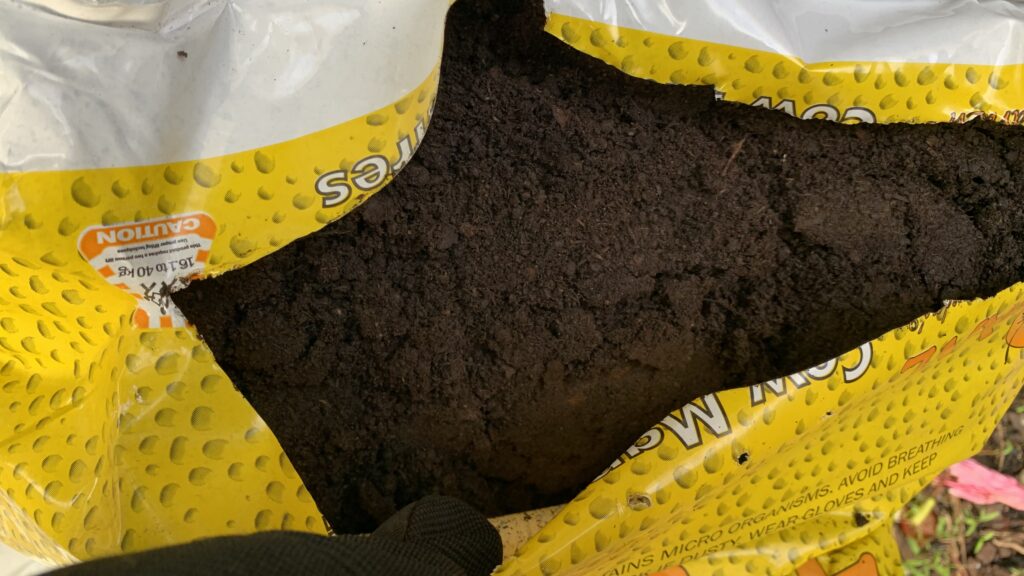
Worm Compost
Worm compost, also known as vermicompost, is another great option for fruit trees. Worms break down organic materials into a nutrient-rich compost which will gently feed your fruit trees for around 6 months. Worm compost contains loads of beneficial microorganisms and helps to improve soil structure and fertility. It is also easy to make at home with a worm bin.
I have a worm farm sitting a shady corner of my yard. Each week I feed them with food scraps and every 6 months I empty out the worm compost as a top dressing for my trees. Worm castings make fantastic organic soil conditioner for your fruit trees. It will gently feed your trees and the soil bacteria over time.
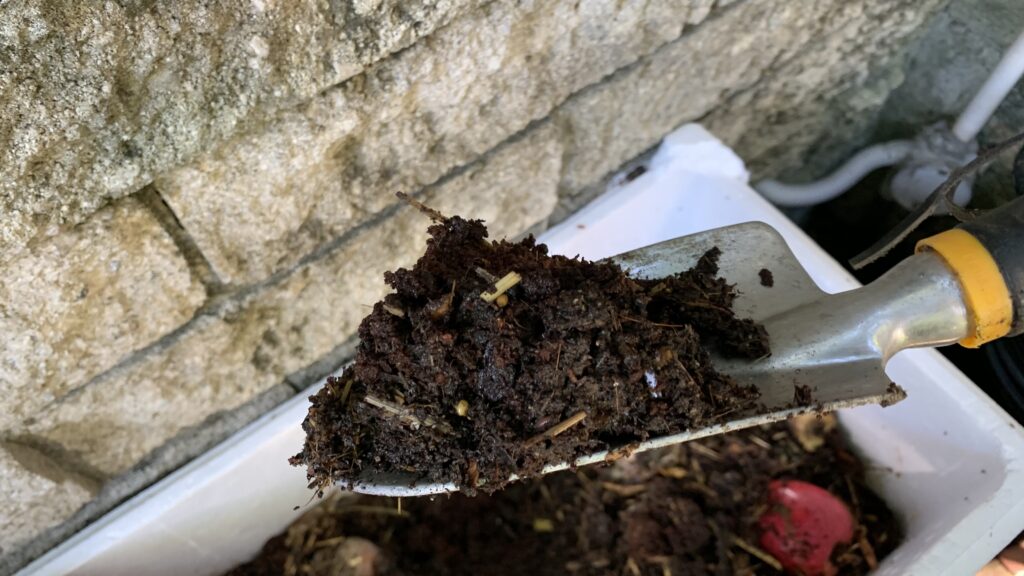
Mushroom Compost
Mushroom compost is a byproduct of mushroom production and is made from a mix of organic materials, such as straw, hay, and poultry manure. It is a great source of nutrients and helps to improve soil structure. Mushroom compost works best for fruit trees when mixed with regular compost.
Mix 50:50 mushroom compost and regular compost together and top dress your fruit trees. Add around 2-3 inches of compost over the root zone, which is under the leaf canopy. Avoid putting the compost right up against the trunk to avoid rot.

Leaf Mould
Leaf mould is made by composting fallen leaves over a period of several months. It is high in beneficial microorganisms and helps to improve soil structure and moisture retention. Leaf mould is also a great source of nutrients and can be used as a mulch around fruit trees.
I like to collect bags of fall leaves and leave them sitting in the corner of my yard. You can also mix them into your regular compost to help them to break down quicker. Leaf mould can also be made by filling a 4x4x4 foot wire cage with fall leaves. Cover the top with palm fronds to stop the leaves from blowing away.
Leaf mould can be used for both established and young trees as a gentle organic fertilizer and mulch. Adding a 3 inch layer of leaf mould to the top fo the soil under your fruit trees will help to keep the water in the soil longer of the hot months of summer.
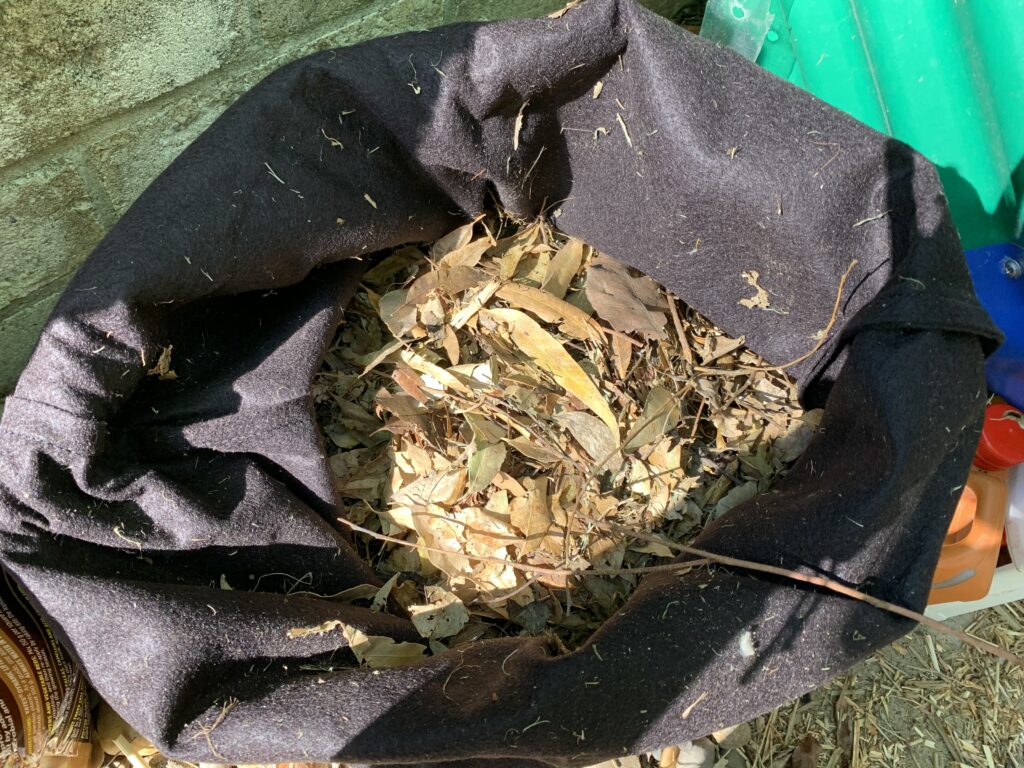
Aged Cow Manure
Aged cow manure is a popular choice for fruit trees because it is high in nutrients and helps to improve soil structure. Cow manure should be aged for at least six months to a year to allow any harmful bacteria to break down.
Aged cow manure should also be mixed with other types of compost to avoid over-fertilizing the soil. I like to add a 50:50 mix of compost and aged cow manure when top dressing my fruit trees. You can then cover it with a 2 inch layer of bark chips to help to keep the moisture in.
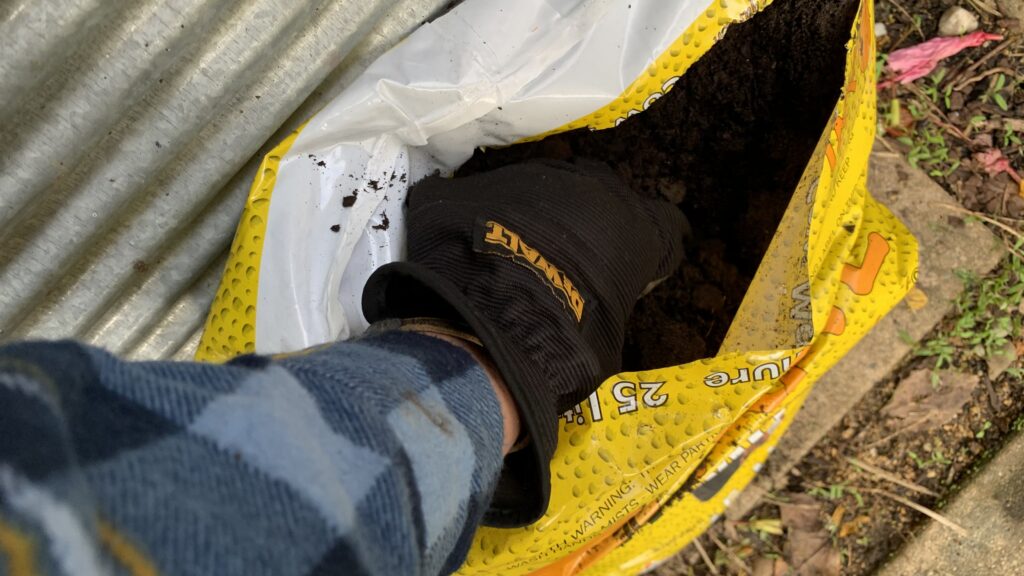
Wood Chips
Wood chips are an excellent mulch for fruit trees and are perfect for adding over the top of a compost top dressing. They help to keep moisture in the soil, stop weeds, and regulate soil temperature, promoting healthy root development. I like to add a 3 inch layer of compost as a top dressing for my fruit trees first in spring, then layer wood chips on top.
Start by clearing the area around the tree of existing weeds and grass. Spread a layer of aged compost first and then add wood chips about 2-3 inches deep, making sure that they are away from the tree trunk.

Leaving a gap around the base of the tree will stop moisture buildup. As the wood chips are broken down by soil bacteria, they enrich the soil with organic matter, and gently feed your fruit tree. The best fertilizers for your fruit tree will be a combinations of organic matter like compost and a good quality organic fruit fertilizer.
Overall, the best compost for fruit trees will depend on your specific needs and the type of soil you have. By choosing the right compost and using it correctly, you can help to ensure that your fruit trees are healthy and productive for years to come. A combination of aged compost, aged cow manure and a top dressing of wood chips works best for my lemon, orange and lime trees.
Importance of Compost for Fruit Trees
Adding compost to the soil before planting your fruit trees or as a top dressing for established trees is a great way to feed the soil, add essential nutrients and to keep your fruit tree moist over the summer. A good idea is to top dress your fruit trees at the start of the growing season in spring each year. Here are some amazing benefits of compost for fruit trees.

Nutrient Supply
Compost is a rich source of nutrients that fruit trees need to grow and produce fruit. The compost provides a slow-release source of essential macronutrients such as nitrogen, phosphorus, and potassium, as well as micronutrients such as calcium, magnesium, and iron.
These nutrients are essential for healthy plant growth, fruit production and providing small amounts of trace elements. This paired with a good quality fruit tree fertilizer applied in spring will get your citrus trees ready to produce loads of fruit. You can use an organic fruit tree food or chemical fertilizers in combination with your compost top dressing.

Using compost also helps to maintain a balanced pH level in the soil. Fruit trees require a slightly acidic soil environment, and compost can help to keep the soil pH in the best range for fruit tree growth.
Improved Soil Structure
Compost helps to improve soil structure by increasing the soil’s water-holding capacity, increasing water retention, improving drainage, and reducing soil compaction. This is important for fruit trees as it allows the roots to access water and nutrients more easily, and also helps to prevent root rot. This is useful for the hottest time of year where the roots of the tree near the surface of the soil are more likely to dry out.
Compost also adds organic matter to the soil, which can help to improve soil fertility over time. This is particularly important for fruit trees, encouraging healthy leaf growth, flower and fruit development and a strong root system.
Disease Resistance
Compost can help to promote disease resistance in fruit trees by providing a healthy growing environment. Healthy trees are less susceptible to disease and will be better able to survive harsh weather conditions. Compost also contains beneficial microorganisms that can help to suppress harmful pathogens in the soil. This can help to prevent diseases such as root rot and canker, which can be detrimental to fruit tree health.
Overall, compost is an essential component in providing the necessary nutrients, soil structure, and disease resistance for fruit trees to thrive. By applying compost to your fruit trees, you can help to ensure that your trees produce high-quality fruit year after year.
How to Apply Compost
When it comes to applying compost to your fruit trees, there are a few different methods you can use. In this section, we’ll cover two of the most popular methods: compost mulching and compost tea.
Compost Mulching – Top Dressing
Compost mulching, also known as top dressing, is a simple and effective way to apply compost to your fruit trees. Here’s how to do it:
- Start by removing any weeds or grass from around the base of the tree. This will help prevent competition for nutrients and water.
- Spread a layer of compost around the base of the tree, making sure to keep it away from the trunk. A layer of 2-3 inches is usually best.
- Add a 1-2 inch layer of bark mulch over the top of the compost.
- Water the area well to help the compost settle in and begin to break down.
Compost mulching has several benefits for fruit trees. It helps retain moisture in the soil, suppresses weeds, and provides a slow-release source of nutrients for the tree.
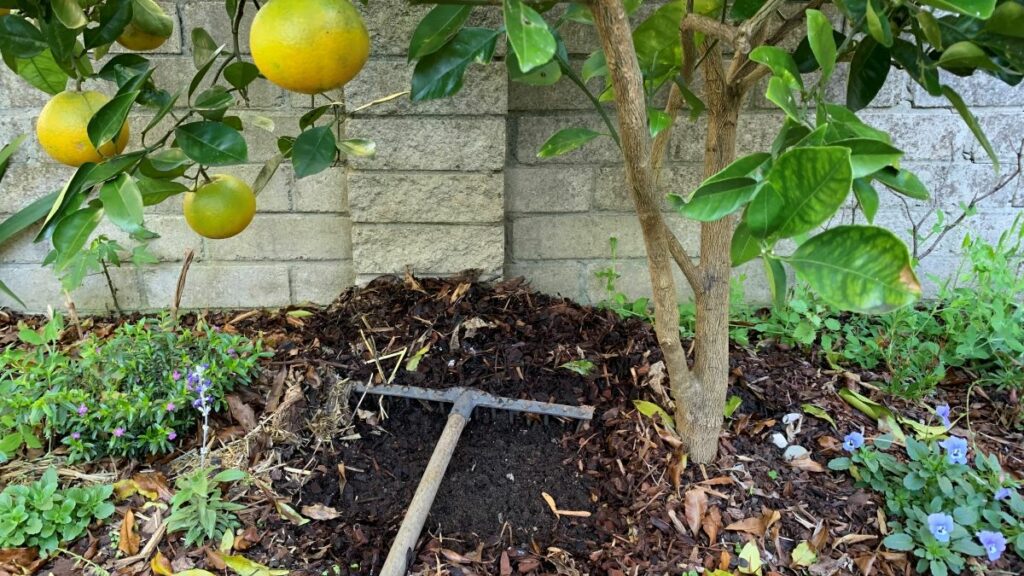
Compost Tea
Compost tea is another popular method for applying compost to fruit trees. It’s essentially a liquid fertilizer made from steeping compost in water. Here’s how to make and apply compost tea:
- Fill a bucket or container with water and add a few shovelfuls of compost.
- Let the compost steep in the water for several days, stirring occasionally.
- Strain the liquid through a cheesecloth or fine mesh strainer to remove any solids.
- Dilute the compost tea with water until it’s the color of weak tea.
- Pour the compost tea around the base of the tree, making sure to saturate the soil.
Compost tea provides a quick boost of nutrients to fruit trees and can help improve soil health. However, it’s important not to overdo it – too much compost tea can lead to excessive growth and weak branches.
Overall, both compost mulching and compost tea are effective ways to apply compost to your fruit trees. Choose the method that works best for you and your trees, and enjoy the benefits of healthy, nourished fruit trees!
Common Mistakes to Avoid When Adding Compost to Fruit Trees
When it comes to adding compost to fruit trees, there are a few common mistakes that you should avoid to ensure the best results. Here are some of the most important things to keep in mind:
1. Over-Fertilizing
One of the biggest mistakes that people make when adding compost to fruit trees is over-fertilizing. While compost is a great source of nutrients for your trees, too much of a good thing can be harmful. It is best to top dress your fruit trees in Spring with a 2-3 inch layer of compost. You can reapply in Fall if the compost has fully broken down by this time. Any more can stop water from reaching the shallow feeder roots and may bury the tree too deeply in the soil.
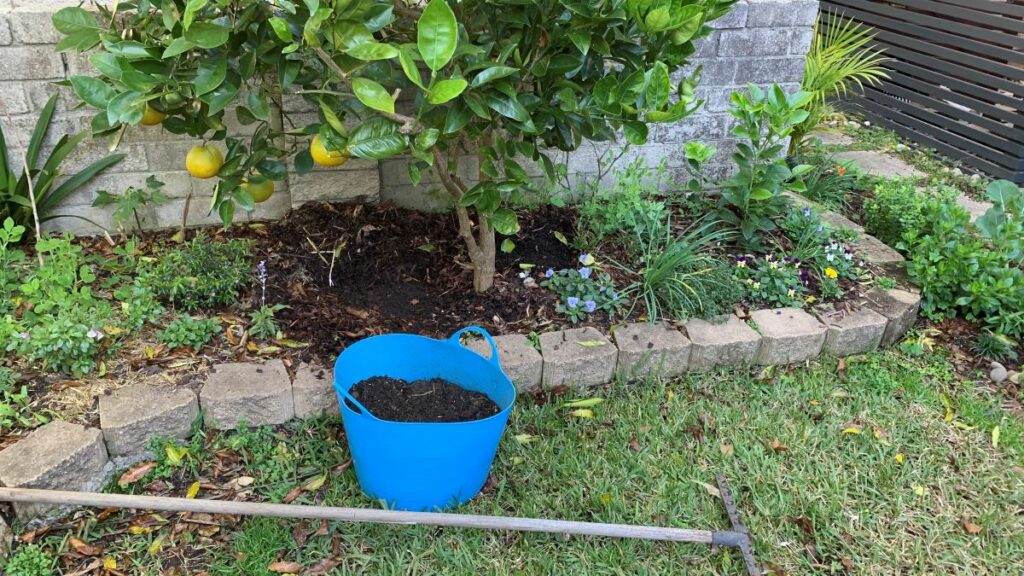
2. Applying Compost Too Close to the Trunk
Another common mistake is applying compost too close to the trunk of your fruit tree. This can lead to a buildup of moisture around the base of the tree, which can attract pests and diseases. It can also cause the bark to rot, which can weaken the tree and make it more susceptible to damage.
To avoid this problem, it’s important to apply compost evenly around the drip line of your tree. This is the area under the outermost branches where rainwater drips off the leaves. Keep the compost at least 2-3 inches away from the trunk.
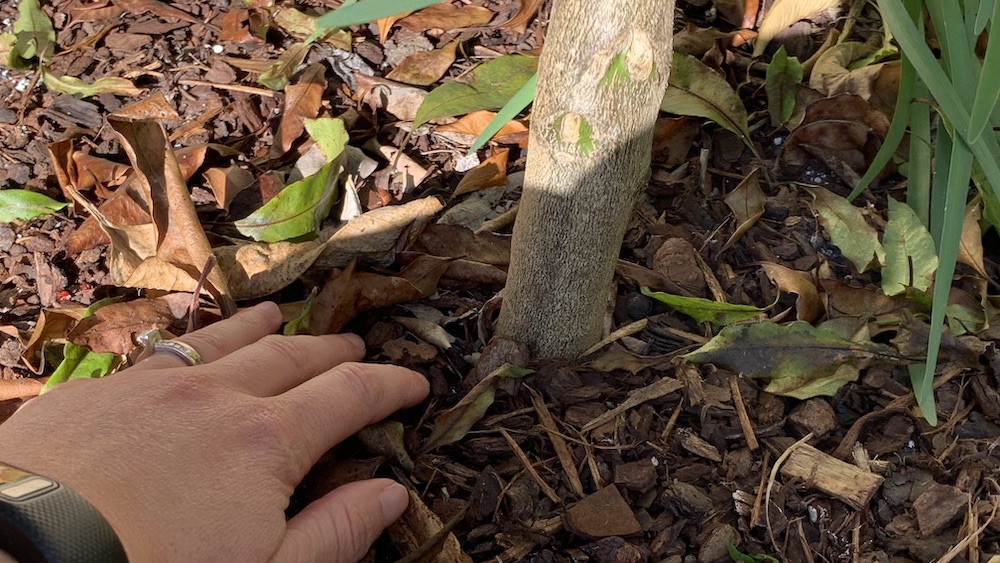
3. Using Uncomposted Materials
Using uncomposted materials in your compost can also be a mistake. These materials can contain weed seeds, pathogens, and other harmful substances that can damage your fruit tree. They can also tie up nutrients in the soil, making them unavailable to your tree.
To avoid this problem, it’s important to use only fully composted materials in your compost. This will ensure that any harmful substances have been broken down and that the nutrients are readily available to your tree. If you are adding homemade compost or worm castings, make sure that it has fully broken down. You should not be able to see any whole food scraps or leaves in your mix.
Summary
Choosing the best compost for your fruit trees is crucial for their overall health and productivity. Compost made from leaves, grass clippings, and other organic matter is the best option for fruit trees. This type of compost helps to improve drainage and prevent the tree from becoming waterlogged. It also provides essential nutrients and promotes healthy root growth.
When it comes to applying compost to your fruit trees, it is important to do so at the right time and in the right amount. Applying too much compost can harm your trees, while applying too little may not provide the necessary benefits. A general rule of thumb is to apply compost in the spring and fall, and to use about one inch of compost per year of the tree’s age.
Remember to always mix your compost pile to ensure that the temperature stays consistent and weed seeds are killed.
Overall, composting is a great way to improve the health of your fruit trees and reduce waste in your garden. By choosing the best compost and applying it correctly, you can enjoy bountiful harvests and healthy trees for years to come.
Frequently Asked Questions
What is the best soil mix for fruit trees?
The best soil mix for fruit trees should be well-draining and nutrient-rich. A good mix should include organic matter such as compost, peat moss, and perlite. A pH level of 6.0 to 7.0 is ideal for most fruit trees.
Is compost or manure better for fruit trees?
Both compost and manure are great for fruit trees. Compost provides a balanced source of nutrients and improves soil structure, while manure adds nitrogen and other essential nutrients. Aged manure is recommended as it provides beneficial microorganisms that help break down organic matter and cycle essential nutrients back into the soil.
When should manure be applied to fruit trees?
Manure should be applied to fruit trees in the fall or winter when the tree is dormant. This allows the nutrients to slowly release into the soil and be readily available for the tree in the spring.
What are the benefits of using cedar mulch for apple trees?
Cedar mulch is great for apple trees as it repels insects and helps to retain moisture in the soil. It also provides a natural look to the garden and can help suppress weeds.
How does cardboard benefit fruit trees?
Cardboard can be used as a natural weed barrier around fruit trees. It also helps to retain moisture in the soil and can break down over time, adding organic matter to the soil. You can lay thin cardboard down under your fruit trees once per year and top dress with compost and bark mulch.
What are the advantages of using mulch for mango trees?
Mulch helps to retain moisture in the soil, suppress weeds, and regulate soil temperature around mango trees. It also adds organic matter to the soil, which improves soil structure and fertility.
I am an accredited practicing dietitian, experienced gardener and a dedicated cook. I love writing and sharing my experience so you can learn from my successes and mistakes.
